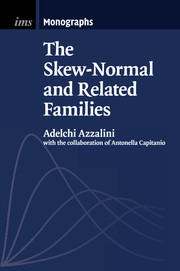Book contents
- Frontmatter
- Contents
- Preface
- 1 Modulation of symmetric densities
- 2 The skew-normal distribution: probability
- 3 The skew-normal distribution: statistics
- 4 Heavy and adaptive tails
- 5 The multivariate skew-normal distribution
- 6 Skew-elliptical distributions
- 7 Further extensions and other directions
- 8 Application-oriented work
- Appendix A Main symbols and notation
- Appendix B Complements on the normal distribution
- Appendix C Notions on likelihood inference
- References
- Index
7 - Further extensions and other directions
Published online by Cambridge University Press: 18 December 2013
- Frontmatter
- Contents
- Preface
- 1 Modulation of symmetric densities
- 2 The skew-normal distribution: probability
- 3 The skew-normal distribution: statistics
- 4 Heavy and adaptive tails
- 5 The multivariate skew-normal distribution
- 6 Skew-elliptical distributions
- 7 Further extensions and other directions
- 8 Application-oriented work
- Appendix A Main symbols and notation
- Appendix B Complements on the normal distribution
- Appendix C Notions on likelihood inference
- References
- Index
Summary
In the remaining two chapters of this book we consider some more specialized topics. The enormous number of directions which have been explored prevent, however, any attempt at a detailed discussion within the targeted area. Consequently, we adopt a quite different style of exposition compared with previous chapters: from now on, we aim to present only the key concepts of the various formulations and their interconnections, referring more extensively to the original sources in the literature for a detailed treatment. Broadly speaking, this chapter focuses more on probabilistic aspects, the next chapter on statistical and applied work.
Use of multiple latent variables
General remarks
In Chapters 2 to 6 we dealt almost exclusively with distributions of type (1.2), or of its slight extension (1.26), closely associated with a selection mechanism which involves one latent variable; see (1.8) and (1.11). For the more important families of distributions, an additional type of genesis exists, based on an additive form of representation, of type (5.19), which again involves an auxiliary variable. Irrespective of the stochastic representation which one prefers to think of as the underlying mechanism, the effect of this additional variable is to introduce a factor of type G0{w(x)} or G0{α0 + w(x)} which modulates the base density, where G0 is a univariate distribution function.
- Type
- Chapter
- Information
- The Skew-Normal and Related Families , pp. 196 - 214Publisher: Cambridge University PressPrint publication year: 2013

